|
|
|
Sort Order |
|
|
|
Items / Page
|
|
|
|
|
|
|
| Srl | Item |
| 1 |
ID:
142783
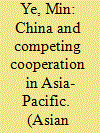

|
|
|
|
|
| Summary/Abstract |
A big question looming large over policy and theory in Asian security is how China will use its newfound wealth and power in the region and with what consequences. The United States has concluded the negotiation of Trans-Pacific Partnership (TPP); ASEAN has promoted the Regional Comprehensive Economic Partnership (RCEP). Both frameworks seek to shape China’s regional behavior and manage rising China. In late 2013, China inaugurated the new Silk Road initiative, which has rapidly gained momentum in the country and among China’s neighbors. American public and policy makers, however, are largely unaware or baffled by the new Silk Road. The article, based on field surveys and extensive documentary analysis, provides the first roadmap on how China views TPP, RCEP, and the new Silk Road. It offers important exploration of how China acts and reacts to regional contestation and what are implications for the region.
|
|
|
|
|
|
|
|
|
|
|
|
|
|
|
|
| 2 |
ID:
179239
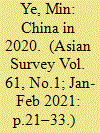

|
|
|
|
|
| Summary/Abstract |
The COVID-19 pandemic wreaked havoc on China, causing tremendous losses. It also accelerated the trend of power concentration, both within the state and inside the Communist Party. With tensions between the US and China mounting in more areas, bilateral relations dropped to the lowest point since the end of the Cold War. On its periphery, China also saw crises of varying intensity over Hong Kong, Taiwan, the Uyghurs, and the disputed border with India.
|
|
|
|
|
|
|
|
|
|
|
|
|
|
|
|
| 3 |
ID:
185197
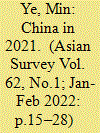

|
|
|
|
|
| Summary/Abstract |
The year 2021 saw unceasing power concentration in China and inside the ruling Communist Party. China persisted with a zero-COVID policy, but at considerable social and economic costs. The investigation of the origins of the pandemic triggered new sparring between China and Western countries. US–China relations continued to sour as the Biden administration kept on with most of the existing China policies and started building a new security network in the Indo-Pacific region. China tightened its control of Hong Kong’s political life, but its effort toward “complete reunification” faced strong resistance across the Taiwan Strait.
|
|
|
|
|
|
|
|
|
|
|
|
|
|
|
|
| 4 |
ID:
181837
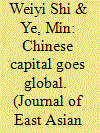

|
|
|
|
|
| Summary/Abstract |
The Belt and Road Initiative (BRI), and China's state-led model for economic globalization more generally, have attracted controversy: Are state-led overseas investment and lending driven by strategic motives or market rationale? How have the recipient economies reacted to the influx of Chinese capital? This special issue sheds light on these questions by first outlining the fragmented state system driving the BRI, a system featuring both Beijing's strategic logic at the top and market considerations in policy implementation. The role of the state is unpacked further in China's globalizing coal industry and in the growth of Chinese industry export to BRI countries. Finally, the issue explores the mechanisms behind public backlash and political pushback facing China in Zambia and Australia. As the COVID-19 pandemic continues to shift China's relationship with the world, this special issue contributes to a more nuanced understanding of the modus operandi of Chinese capital going global.
|
|
|
|
|
|
|
|
|
|
|
|
|
|
|
|
| 5 |
ID:
177882
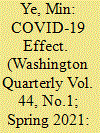

|
|
|
|
|
| Summary/Abstract |
The COVID-19 pandemic has exacerbated geopolitical tensions between the United States and China while restricting policy dialogues, amplifying extreme sentiments, and sidestepping rational observations. The outcomes are extremist and divided narratives, emphasizing China's triumphalism on one hand and inherent weaknesses on the other. Under such narratives, China’s policy voices and actions in combatting the pandemic and economic fallout were under-studied and discounted, with harmful impacts on the US response to the virus, economic recession, and shifting globalization. This paper studies China’s official statements, research reports, and scholarly opinion networks in 2020 and finds that, though there were various policy discussions, the general argument was for expanding China’s globalism during and after the pandemic. Meanwhile, China’s policy actors—national agencies, local governments, and state-owned enterprises (SOEs)—strive to continue globalization and adapt to new realities after COVID-19.
|
|
|
|
|
|
|
|
|
|
|
|
|
|
|
|
| 6 |
ID:
160815
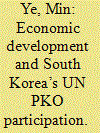

|
|
|
|
|
| Summary/Abstract |
In this paper, we develop a theory on how economic development in South Korea has reshaped its foreign policy and examine the rising middle power’s personnel contributions to the United Nations (UN) peacekeeping operations (PKOs) using a supply-side rational choice model. Not only do the results reaffirm economic development as the fundamental driving force of South Korea’s growing contributions to UN PKOs, a handful of factors that influence South Korea’s decision on UN PKO participation were also discovered. This study highlights an important approach to bridge our knowledge of the global peacekeeping endeavors and individual countries’ self-interested calculation.
|
|
|
|
|
|
|
|
|
|
|
|
|
|
|
|
| 7 |
ID:
189011
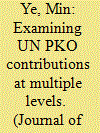

|
|
|
|
|
| Summary/Abstract |
Most empirical studies on states’ personnel contributions to UN peacekeeping operations (PKOs) use a state’s annual contributions as the unit of analysis. A critical problem of the state-level analysis is that it ignores the fact that states have to decide how to distribute these peacekeepers among more than a dozen peacekeeping missions. Ignoring the mission-level decision misses a significant part of states’ UN PKO contributions and could bias our empirical analysis. We propose a two-level model that sees a state’s UN PKO contributions as the interactions between the state-level and mission-level factors. This model is employed to revisit the heatedly debated “reimbursement hypothesis”. Our analysis of the empirical data between 1990 and 2018 shows a mixed relationship between states’ economic development and their UN PKO contributions. We also find that middle-income rather than low-income countries are the most critical providers of UN PKOs since the end of the cold war.
|
|
|
|
|
|
|
|
|
|
|
|
|
|
|
|
| 8 |
ID:
167482
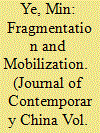

|
|
|
|
|
| Summary/Abstract |
The Belt and Road initiative is five years old and has resulted in voluminous publications by scholars and policy pundits in many corners of the world. It is by far the most watched foreign policy initiative that the PRC has projected on the world stage. Departing from the standard focus on BRI’s external ambition, this article investigates the political dynamics inside the Chinese state, which has driven and will continue to shape the contour and magnitude of the BRI in the future. The article builds a theory of state fragmentation and argues that the Belt and Road is a mobilization campaign by the Communist leadership in order to deal with domestic and diplomatic challenges. Mobilization, however, intensifies fragmentation and results in the decentralized implementation of the BRI that diverges from the rhetoric of the strategy. Lower-level governments and major business groups leverage on the BRI and devise projects and programs that serve their economic interests. On the one hand, economic growth is being revived in the localities; on the other, restructuring and rebalancing of the Chinese economy are delayed.
|
|
|
|
|
|
|
|
|
|
|
|
|
|
|
|
| 9 |
ID:
181838
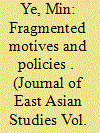

|
|
|
|
|
| Summary/Abstract |
Observers have portrayed the Belt and Road Initiative (BRI) variously, as China's great-power strategy, global infrastructure initiative, or commercial projects. Each characterization has had logical reasoning and evidence to support it. But how? How has one initiative been shown to have such varied motives? This article unpacks the Chinese state and establishes that a “tri-block” structure consisting of political leadership, bureaucracy, and economic arms has accounted for such varied motivations and actors in the BRI in China. In the BRI process, the leadership employed strategic rhetoric, and bureaucracies imposed policy ideas. Yet, more pervasively, the implementers have followed commercial motives in specific projects. BRI's strategic rhetoric and hazardous investment have generated external critiques and anti-China backlash, forcing Beijing to readjust the initiative. However, given the tri-block state structure, Beijing's policy adjustment will not be sufficient. Economic actors’ incentives need to be shifted too.
|
|
|
|
|
|
|
|
|
|
|
|
|
|
|
|
| 10 |
ID:
174819
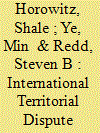

|
|
|
|
|
| Summary/Abstract |
Within international relations theory, there is significant disagreement on the nature and significance of leaders’ dispute outcome preferences. While many variants of realism assume that such preferences are relatively fixed and homogeneous, both the liberal and the constructivist schools view them as significant variables. This debate remains unresolved because, for the standard large-sample conflict data sets, there are no direct measures of leadership preferences over outcomes in given types of international disputes. Using a conflict bargaining experiment, we ask whether, after controlling for the effects of relative power and initial conditions, leadership preferences have a statistically significant impact. We use two different country samples—from China and the United States—to examine whether the impact of leadership preferences varies internationally. We find that realist-style preferences are a special rather than a general case, and that such differences have significant implications for understanding continuities and changes in Chinese and US foreign policies.
|
|
|
|
|
|
|
|
|
|
|
|
|
|
|
|
| 11 |
ID:
080149
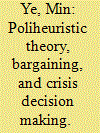

|
|
|
|
|
| Publication |
2007.
|
| Summary/Abstract |
In the past decade, the application of the Poliheuristic (PH) theory to foreign policy decisions of various types, by numerous leaders, and in association with different research methods, has demonstrated its theoretical merit in integrating the divided rational choice and psychological/cognitive approaches. This article argues for a complementary relationship between PH and formal theory. On the one hand, PH can provide a framework in which abstract formal models can be connected with specific domestic as well as international circumstances. On the other hand, formal theory sharpens the rational analysis used in the second conceptual stage of PH. In this study, I formulate a revised Rubinstein bargaining model with war as an outside option and apply it to Chinese crisis decision making during the Second and Fourth Taiwan Strait Crisis. In sum, this study makes three contributions to the literature on international crises and foreign policy analysis. First, it gives formal explanations on how PH can contribute to the game-theoretic approach in foreign policy analysis. Second, it presents what Bueno de Mesquita and Lalman (1992) called a "domestic politics version" of the canonical Rubinstein bargaining game, connecting international interactions with individual participants' domestic politics. Finally, it provides a way to test abstract game-theoretic models in particular domestic and international contexts of foreign policy making.
|
|
|
|
|
|
|
|
|
|
|
|
|
|
|
|
| 12 |
ID:
175842
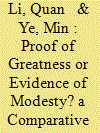

|
|
|
|
|
| Summary/Abstract |
Any serious discussion about the consequences of China’s rise must start with a systematic and rigorous assessment of China’s actual influence and status in the international system. In this article, we examine a widely used indicator in the debate about China’s international status. Although many existing studies see China’s active participation in United Nations (UN) Peacekeeping Operations as incontestable evidence of China’s great power status, others contend that it signifies the status of only a middle power. We posit that China’s policy behaviour should be evaluated in a comparative manner, and from a dynamic perspective. After comparing the patterns and features of China’s personnel contributions with that of 20 other major countries in the world, we find that China’s behaviour is more similar to that of developing ‘middle powers’, such as Turkey, India, and Brazil, as opposed to established ‘great powers’ such as other permanent members of the UN Security Council or traditional ‘western middle powers’.
|
|
|
|
|
|
|
|
|
|
|
|
|
|
|
|
| 13 |
ID:
151729
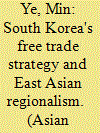

|
|
|
|
|
| Summary/Abstract |
South Korea is probably the most active state in the surging wave of East Asian regionalism. It has aggressively pursued free trade agreements (FTAs) with partners across the world in the past decade. My study focuses on the particular procedure of South Korea's FTA formation. I develop a multistage approach to examine how South Korea proposes, negotiates, signs, and ratifies FTAs with other countries. Using South Korea's data on trade with 122 trading partners from 1995 to 2012, the study offers a systematic examination of various South Korean FTA strategies at these stages. The findings demonstrate both similarities and differences between South Korea and its East Asian counterparts.
|
|
|
|
|
|
|
|
|
|
|
|
|
|
|
|
| 14 |
ID:
143337
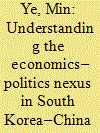

|
|
|
|
|
| Summary/Abstract |
A very interesting observation in recent South Korea–China relations is the sharp contrast between their “hot” economic and “cold” political ties. This article proposes to understand the “trade–conflict” relations from the perspective of the two states’ grand strategy of foreign policy. At the bilateral level, Vector Autoregression models are employed to test the Granger causality between Sino-South Korean bilateral trade and political relations. At the regional level, the two states’ economic and political ties with other regional powers in Northeast Asia are examined. The findings reveal different patterns in South Korea and China’s grand strategies to balance their economic and political goals.
|
|
|
|
|
|
|
|
|
|
|
|
|
|
|
|
| 15 |
ID:
165023
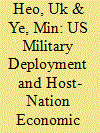

|
|
|
|
|
| Summary/Abstract |
Since the end of World War II, the U.S. military has deployed its troops all over the world for regional security and/or peace building. Despite the importance of its political, economic, and military impact on the region, few studies examined how U.S. military deployment overseas affects the host nation’s economy except Jones and Kane (2012) and Kane (2012). To help fill the gap in the literature, we tested how substantial U.S. troop deployment (more than 100 troops on average) affects the host state’s investment, trade, political development, and economic growth for the period from 1960 to 2014, using the seemingly unrelated regression (SUR) model. The results show that the presence of U.S. troops does promote investment, trade, and economic growth in the host state. The United States deploys troops for regional security purposes, but these deployments also help economic growth directly and indirectly.
|
|
|
|
|
|
|
|
|
|
|
|
|
|
|
|
| 16 |
ID:
147310
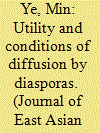

|
|
|
|
|
| Summary/Abstract |
Diffusion studies have rightly emphasized external ideas and resources that propel liberalization in the developing world. There remain two gaps: first, the literature has not covered the types of diffusers and the ways diasporas may shape liberalization in their homelands; second, it pays little attention to internal diffusion after national adoption within a country. This article explores the utility and conditions of diffusion by diasporas and examines the roles of diasporas and internal diffusion in China and India's FDI liberalization. In both countries, diasporas were main diffusers that led national adoption of liberalism at home. In China, however, entrepreneurial diasporas' networks with local governments helped expansive internal diffusion. India's professional diasporas did not strongly engage local governments or domestic companies. National adoption in India was followed by reversal and partial internal diffusions. India's software services provide a similar diffusion by diasporas to that in China.
|
|
|
|
|
|
|
|
|
|
|
|
|
|
|
|
|
|
|
|
|